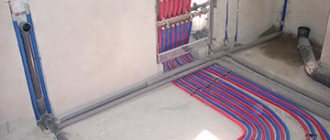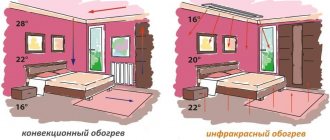We use the heat of the earth to heat the house
Earth energy for home heating
Nowadays it is used infrequently - many people prefer to use classical energy sources. But fuel prices regularly become higher, and gas, coal and oil deposits will eventually run out, even after many years. Because of this reason, there is a need to look for alternative heat sources, especially the heat of the earth for heating a house.
Heating a house with the heat of the earth is one of the best when compared with solar and wind energy. In European countries right now, solar systems are very popular, allowing the use of the sun's rays to heat a house and heat water (read also: “Do-it-yourself solar systems for heating”). But their use is limited - if in countries with a warm climate they are enough to actually heat a home, then in regions with a climate of temperate latitudes there are a lot of cloudy days. Moreover, solar collectors must contain a decent area and a capacious heat accumulator, and as a result, creating a heating system costs a considerable amount (read: “Do-it-yourself solar heating device”).
It also doesn’t hurt to have an additional heat source in case of prolonged bad weather. Wind energy is also considered not a very good option: its strength changes, and folds in the landscape help create places with constant calm. If you use the heat of the earth to heat your house, then you will not need an additional energy source - on any day the soil at a depth of several meters maintains a stable temperature. The greater the immersion depth of the geothermal pump, the higher the soil temperature, and based on this, the efficiency of heat supply (more details: “Geothermal heat supply: working principle with examples”). But don’t forget about the depth of freezing – it varies in a wide variety of regions.
Operating principle and types
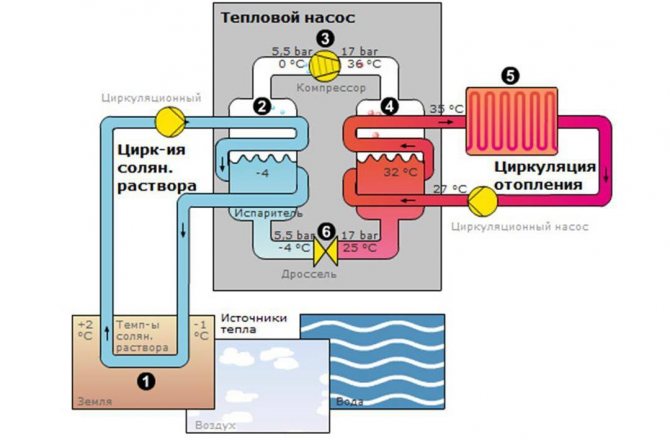
The operating principle of a heat pump. (Click to enlarge)
The principle of operation of a geothermal heat pump is quite simple and is somewhat similar to a refrigerator, only on the contrary it heats and does not cool.
This is a closed-type engineering structure consisting of the heat pump itself, heat exchange pipes and a heating system. A special brine solution circulates through the pipes, all powered by electricity.
Due to the circulation of the solution, heat is taken from the environment, supplied to the heat pump, where it is heated to the desired temperature, then to the heating system and water supply.
The climate of central and southern Russia allows heat pumps (collectors) to be placed at shallow depths, but the main thing is that they are below the freezing level of the soil, which in turn averages a depth of one to one and a half meters.
You may be interested in an article about heat pumps for heating your home.
Read an article on how to calculate the power of a heat pump for heating here. There are different methods of extracting heat from the environment, depending on the location of the heat pump (collector), which we will now consider:
- vertical placement of the collector;
- horizontal placement of the collector;
- ground-water placement of the collector;
- water placement of the reservoir.
Vertical placement of the collector. When the collector is placed vertically, wells of varying depths are drilled, depending on the geological features of the area and climate, if necessary, up to 170 meters, into which heat exchange tubes (collectors) are installed. This method of placing the collector is convenient if there is not enough free space around the building. Horizontal placement of the collector.
If there is enough free space around your building, you can place the collectors horizontally.
In this option, heat exchange tubes are buried horizontally into the ground to a depth of 1.5 to 6 meters.
Ground-water placement of the collector.
In this type of placement, wells are drilled to underwater sources, and heat exchange occurs with water at the bottom of the well, and this same water circulates instead of a special brine solution.
Water placement of the collector. If you are lucky and your house is located on the shore of a pond or you have created a pond yourself, then you can use the type of water placement of the collector - this is perhaps the easiest way to place heat pipes.
There is no need to dig or drill anything, just immerse the pipes in the water using special weights, but do not forget that the depth of the reservoir must be sufficient and exceed 1.2 meters.
When water freezes in winter, if the pipes are not deep enough, they can be damaged by ice and compromise the integrity of the system.
Pool heat pump:
Geothermal pumps that use heat from the earth to heat a home
Heat supply from the earth's energy occurs through a specialized device - a geothermal pump.
The meaning of its work is similar to a refrigerator:
- the gaseous refrigerant is compressed by the compressor, and at the same time becomes very hot;
- the refrigerant passes through a heat exchanger, giving off excess heat and cooling to home temperature;
- After cooling, this substance enters the cooling circuit of the freezer, where it then becomes wider. As a result of a change in the state of aggregation from liquid to gaseous, the refrigerant suddenly cools down and cools everything around it;
- then it goes back to the compressor, and the cycle repeats again.

Home heating using earth energy occurs in a similar way. For example, a refrigerator takes heat from a cold object and transfers it to a warm object, similarly, heat is transferred from freezers with sub-zero temperatures into the space of the room. The amount of pumped energy is many times greater than the electricity consumed by the compressor.
Heat supply from the heat of the earth is more efficient - the heating output is three times the amount of electricity consumed. If we compare a heat pump with a refrigerator, then in this case the soil, which has a stable temperature, replaces the freezer. When developing heating systems, it is necessary to install not only heating devices for heat transfer, but also a heat exchanger on the reverse side of the circuit, which will take heat from the ground.
Collectors come in two varieties:
- vertical;
- horizontal.
Before you start using heat from the ground to heat your house, you need to decide on the type of collector. You can look at the photo to see how they look.
How Geothermal Systems Work
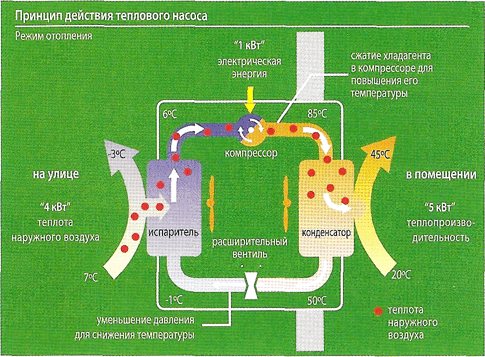
Operating principle of a heat pump
Heating using the heat of the earth is no longer a myth, but a common practice.
Geothermal heating systems can operate on the principle of physically transferring thermal energy from the environment to a refrigerant.
A similar process is observed in the operation of a conventional refrigerator.
More than 75% of the total volume of heat that can be released during the operation of a system that heats a house with the heat of the earth is environmental energy.
Subsequently, it accumulates and then enters the living rooms and other rooms of the cottage or country house.
Experts point out that this type of energy has an amazing ability to self-heal, so the geothermal heating system does absolutely no harm or damage to the energy or ecological balance of the environment and our planet.
The heating system has one important advantage - it is absolutely safe to use.
Equipment that won't take up much space.
Heating a private house with the heat of the earth began to be actively introduced quite recently. Experts call the main reason for the emergence of such heating systems for private homes energy crises, which often appeared in the 70s of the 20th century.
At first, heating with earth's energy was considered a luxury, so only the richest and most elite families could afford a completely innovative home heating system.
Further, due to the active development of science, technology and the emergence of completely new technologies, geothermal heating systems became increasingly widespread, and the cost of their installation and maintenance decreased.
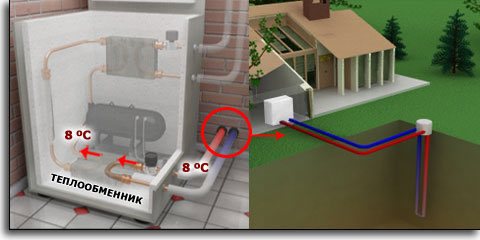
The heat pump takes up very little space in your home
Today, a small family, even with an average income, can afford to install a system for heating their home without seriously disrupting their family budget. Modern geothermal equipment has been qualitatively improved and modernized.
Improvements to systems continue to this day, as the creation of new units leads to reduced energy consumption and greater savings.
Such heating systems operate at a qualitatively new level, because new and unusual fuel, such as earth energy, is used for air conditioning and heating a private home.
Heating a private home with the heat of the earth is popular in all corners of the planet.
After all, it is precisely this energy that can create cozy, comfortable and optimal conditions for the life of every person, and does not pollute the environment with harmful and negative substances, as happens during the combustion of peat, coal or gas.
Geothermal heating can easily operate without any combustion processes, so owners do not have to worry about the issue of fire and explosion of the system, it is completely safe to use.
Horizontal collectors for heating a house with earth's heat
They are used in regions with a relatively warm climate, where the depth of soil freezing will not be more than 1-1.5 meters. , organizing home heating from the ground is much easier, because ditches can be dug on your own, and the cost of the work will be noticeably lower.
But such a scheme also has disadvantages. First of all, it is difficult to make a heat supply from the ground with your own hands: for example, for a house with an area of 275 square meters, you will need to put 1200 meters of pipes in the ditches. In addition to the fact that you will need to spend enough time digging ditches, the pipes will also take up a decent area. This area cannot be used, for example, for a garden or vegetable garden: the roots of the plants will freeze due to the specifics of the collector’s operation.
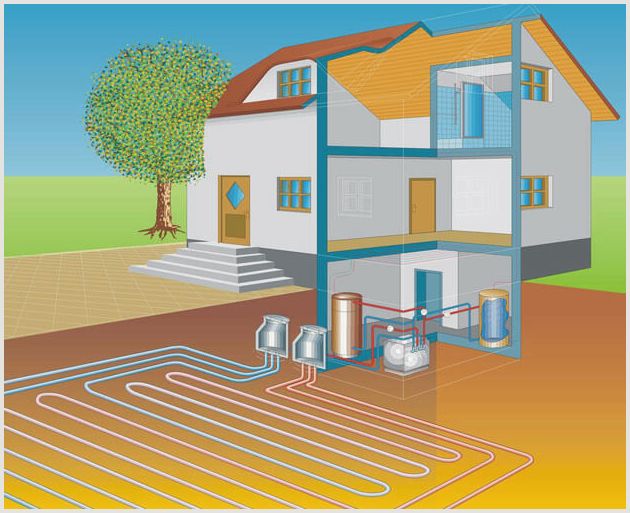
Likewise, ground heating is considered a great idea, but very difficult to implement. The situation is similar with solar heating. Actually, because of this reason, environmentally friendly energy sources are not very popular nowadays.
Geothermal heating of the house: principle of operation
Geothermal heating is similar in principle to a refrigerator, except for heating purposes and it is becoming popular. The earth retains heat constantly and can heat objects on its surface. The whole point is that from the nutria the earth warms up with the help of magma, and the surface does not freeze due to the soil.
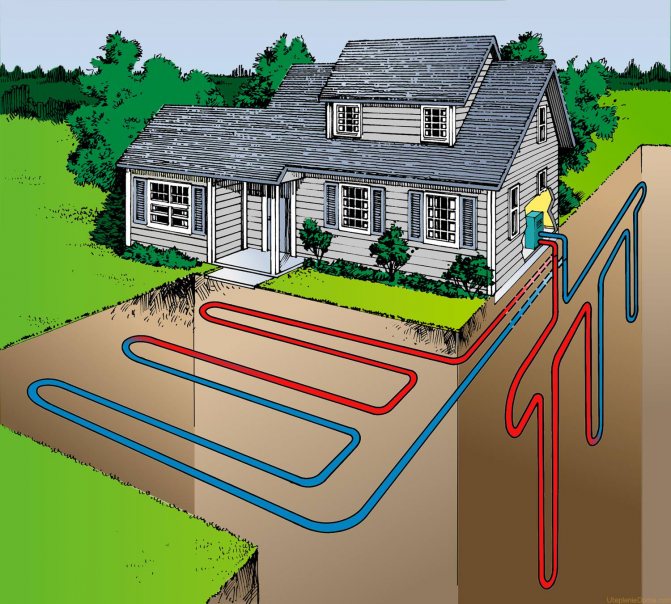
Thermal energy is created through heating; it is used by a geothermal installation, the operation of which is based on heat pumps.
The operating principle of this system is as follows: a pump is installed on top, after which a heat exchanger is lowered into an organized shaft. Groundwater enters the heat exchanger and is heated. The resulting heat is used for industrial and domestic purposes.
This system is environmentally friendly and efficient; the operating principle of this system can be implemented in 3 ways:
- Use of thermal energy from groundwater located at great depths. Water in deep soils has a high temperature; the heat pump raises and warms it up.
- This method requires a lot of expense. A hole with a depth of 75 meters is drilled in the ground, and a reservoir with antifreeze is lowered there. The antifreeze warms up and is directed to the heat exchanger using a pump. After the antifreeze has released thermal energy, it goes back into the reservoir.
- There is no need to create a mine for this method. It is suitable for heating buildings that have access to bodies of water. The construction principle is as follows: heat exchanger probes are placed at the bottom of the reservoir, which create heat at the bottom of the pond.
You can choose the appropriate method based on the area in which you live.
Air manifolds
Underground heat supply to a private house can also be achieved using air collectors. This is a very simple method of air heating in a private house compared to the previous 2.
To warm the air in a room to the optimal temperature, a certain amount of heat is required. The lower the initial temperature, the higher the costs. With the help of a ventilation system and heat obtained from the soil, you can increase the air temperature in the house for free. Heating the earth with heat in this case is very simple.
To organize heating systems you need:
- bring the ventilation air intake below the ground freezing level;
- install a curved, straight or multi-pipe collector using ordinary sewer pipes (the shape is selected depending on the site, for every square meter of the house there should be 1.5 meters of collector);
- perform an air vent at the end of the collector farthest from the house, bringing the pipe to a height of at least 1.5 meters from the ground and equipping it with a deflector umbrella (of course, the air flow into the house will be forced.
In this case, the earth heating system will not be able to fully provide the house with heat.
Still, it allows you to implement two ideas:
- The air entering through the ventilation can be heated by any heating device (gas, solar, electric, etc.) and then distributed throughout the rooms using ventilation ducts. Such heating from the ground will not be completely free, but the costs will still decrease: it will not be the cold air from the street that will be heated, but the air that has already been warmed up to approximately +10 degrees. You can save quite a lot if the winters in the region are cold.
- Air heated using the heat of the earth can be used to blow the external unit of a conventional air conditioner or air-to-air heat pump. Any device of this class will be able to work well at a temperature of approximately +10 degrees. The difficulty of implementation lies only in ensuring the necessary air flow. As a result, the air is heated by the heat of the soil, enters the heat pump and is discharged outside the house.
Heating with earth's heat is a good replacement for conventional heating methods, but now it is not considered widely popular (read also: “Alternative heating for a private home - there is a very wide choice”). This is usually due to the complexity of the installation process and high initial costs. An excellent option is to drill wells and place pipes in them, but this type of heating system is very expensive. On the other hand, this makes it possible to heat the house using a free heat source.
You should also always remember that this heating option is environmentally friendly and very effective, because the soil temperature at a depth of more than ten meters remains constant. Video about how to use the heat of the earth to heat a house:
Operating principles of geothermal heating
Heating using earth energy has been successfully used in various climatic zones: the systems can operate in both southern and northern regions.
During its operation, a geothermal installation uses the physical property of some liquids, such as the ability to evaporate, which leads to cooling of the surface. This phenomenon underlies the operation of refrigeration equipment.
The operating principle of geothermal heating is a cooling process running in reverse. This is how air conditioners work, capable of not only cooling, but also heating the air in the room.
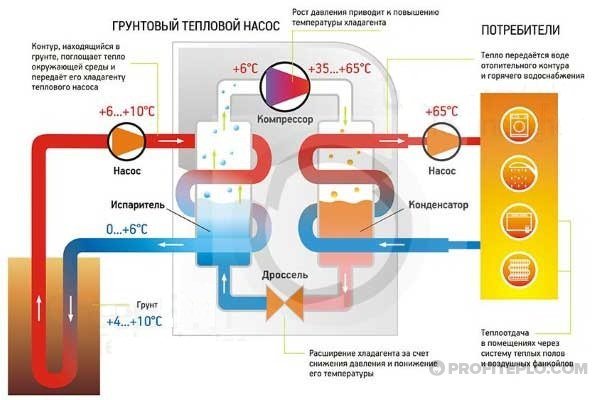
Working principle of a heat pump
However, air conditioning units have limited performance - they cannot function at temperatures below -5°C. A geothermal system can provide heating to a home regardless of the surface air temperature. This is due to the fact that in the environment from which it takes thermal energy, stable temperature conditions are naturally maintained.
How to use the free heat of earth and water? Geothermal home heating: working principle

UPS is an uninterruptible power supply. This is a device that maintains power to electrical appliances during a power outage.
They are constantly used simultaneously with a computer or servers when it is necessary to maintain operation 24 hours a day . UPS operating on a geothermal basis do not allow a house with an electric boiler to cool down.
Specifics of Geothermal Home Heating
Geothermal heating is a type of heating system in which energy is taken from the ground .
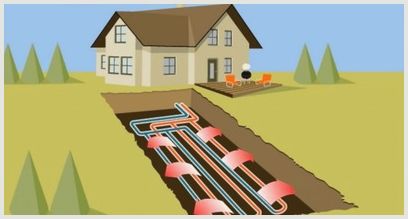
A system of this kind can be built with your own hands; for this reason they are in demand in European countries , as well as in central Russia . However, some believe that this is a fashion that will soon pass.
It is difficult to heat large rooms with such equipment , due to the fact that the soil temperature in the places where the pipe coils are located is generally 6-8 °C .
But very elite equipment, which is designed for production scale, is capable of generating a significant amount of energy . Only devices of this type are extremely expensive .
Working principle
Thermal energy is taken from the ground by specialized heat pumps . Pipes are lowered into the ground through which liquid moves, which heats up and delivers heat to the house. As the gas contracts and expands, the temperature changes; this temperature is enough to heat a house.
Reference! The process is called the Carnot cycle . The discovery happened in the first half of the 20s of the 19th century by the French physicist Sadi Carnot. Refrigerators work according to the same scheme, as well as a heat engine invented by Carnot himself.
The device consists of three circuits and a pump that supports exchange between processes in the middle of the system, the number of which is three .
Inner circuit
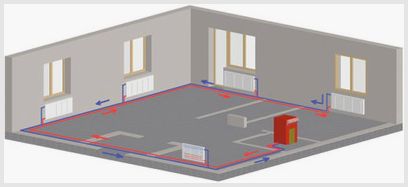
This circuit is filled with water or a special liquid called thermal fluid . Consists of pipes and a heating device .
The purpose of the internal circuit is to heat the coolant, which moves through the system and heats the entire house. It is necessary to note that the internal contour prevents the ground
around the unit.
In the middle of the circuit there is a non-freezing liquid , the circuit itself is located deep underground, below the frost depth . Designed to collect heat energy from the ground. Then the thermal energy is transferred to the freon circuit.
Freon circuit
The key circuit in the middle of which freon boils . Therefore, a significant amount of gas is released, on which the operating principle of the system is based.
Main! The boiling point of freon is very low.
Prospects for the development of geothermal systems
Geothermal heating systems have low popularity due to their cost. So, for a house of approximately 200 m2, a turnkey geothermal heating system costs about one million rubles, the lion’s share - 30%, a heat pump.

In the Baltic countries and Western Europe, when a home owner installs a system based on self-healing heat sources, then the state compensates part of the costs of installing this system. At the same time, the payback period for a geothermal heating system is up to 5 years. Since the system is fully automated and does not require human intervention, the level of comfort is much higher than with heating with other types of fuel. The choice is yours.
How different types of geothermal systems work
There are 3 types of heat exchangers, each of them has its own advantages . The choice depends on the type of terrain, the size of the area where the equipment will be located, the area of the room that is heated, the presence of a reservoir, and other factors.
Any of the systems is not cheap, but it is economical in terms of use, and the power of the unit depends on the use. The main difference is the type of heat exchanger .
Vertical heat exchanger
The main advantage is saving space . Perfect for small areas. For example, equipment of this kind can be kept not under the house, but under a hill, without disturbing the landscape, but for this it will be necessary to use powerful drilling equipment for greater depth.
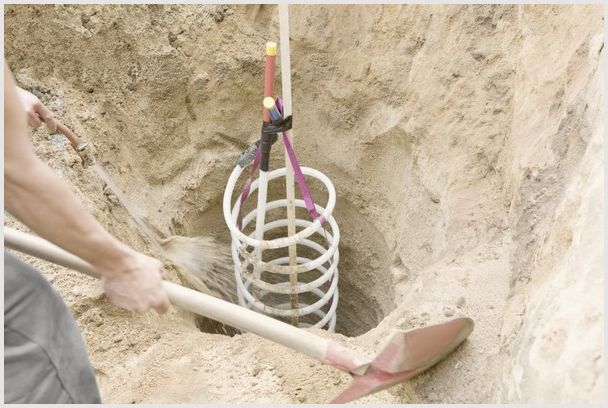
Photo 1. Burying a vertical geothermal heating shaft. Spiral-wrapped pipes descend deep into the ground.
The average depth is 150 meters and the diameter is 15 cm .
Horizontal heat exchanger
It will not be possible to plant a vegetable garden over such a system . It is perfect for heating large rooms from 300 m2 . Underground there is not just a well, but a whole system of pipes in specialized tunnels.
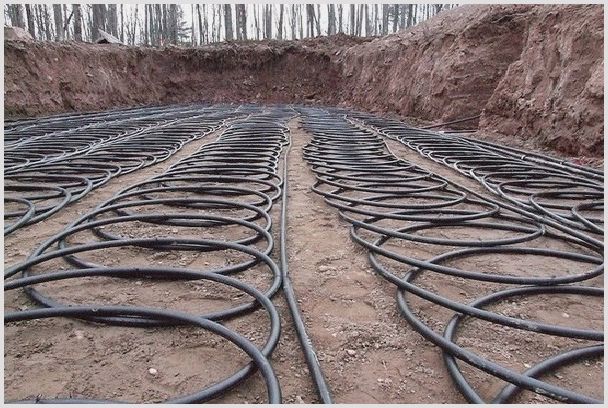
Photo 2. Geothermal heating with pipes laid in a horizontal position: the pit depth is small, but the area is large.
The ratio of the equipment area to the area of the heated area 1 to 3. These are very spacious dimensions.
Located in a body of water
A system of this type, of all those proposed, is one of the most economical . But there is one sign without which work is not possible: the presence of a body of water nearby . The reservoir must first be located at a distance of up to 100 meters from the heated area.
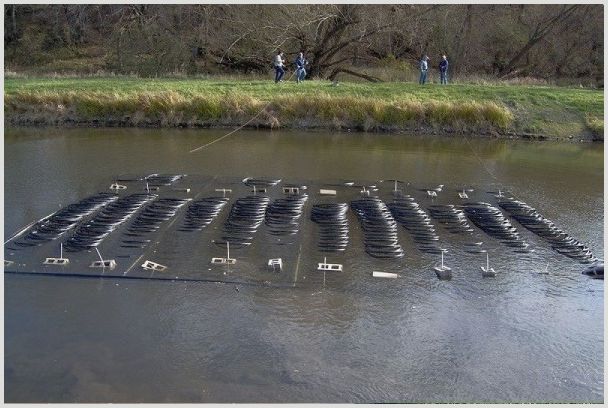
Photo 3. Geothermal heating placed in a body of water: pipes with a thermal fluid are immersed in a nearby pond.
In this case, thermal energy is taken not from the earth, but from water .
Advice. The area of the reservoir must be more than 200 m2 .
Designs of geothermal heating systems
When installing a geothermal system, the differences mainly concern only the external ground collector. There are four main circuit placement schemes:
- Horizontal - the ground collector is placed below the freezing depth of the soil (from one to one and a half meters - for different regions of the country). The following pipes are used for the external collector: metal-plastic, copper in a PVC sheath. The heat transfer of the earth is 10-25 W/m2 and up to 50 W/m2 for soil with a high groundwater level. To obtain 7-9 kW of thermal energy, the collector area will be 300-500 m2, depending on installation conditions. When installing the collector in this way, it is not allowed to dig trenches near trees closer than 1.5 m. It is necessary to carry out landscaping and landscaping work upon completion of installation of the system.
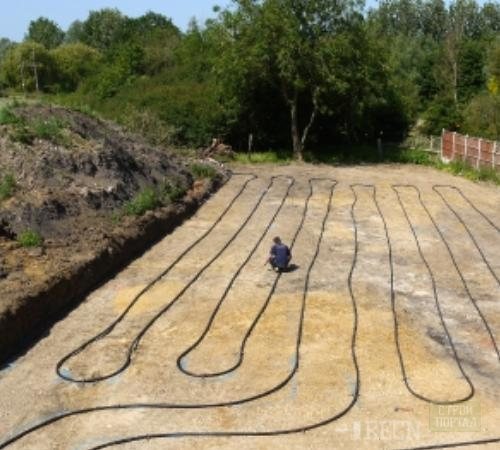
- Vertical placement - for installation, several wells are drilled, in different directions and at different angles. Geothermal probes are placed in wells. In this case, the heat transfer is about 50 W/mp. Thus, to obtain the same 7-9 kW of thermal energy, 150-200 meters of wells are needed. At the same time, the landscape design of the site will not be affected; very little space is needed to install the caisson and place the prefabricated collector in it.
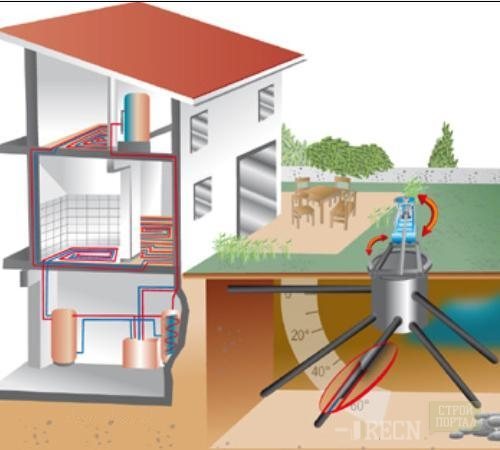
- Water-based circuit - an external heat exchanger is mounted in a nearby body of water at a depth of 2-3 meters. One of the main requirements for this arrangement of the heat exchanger is the proximity of the house to the reservoir up to 100 m, and the surface area of the reservoir must be at least 200 m2.
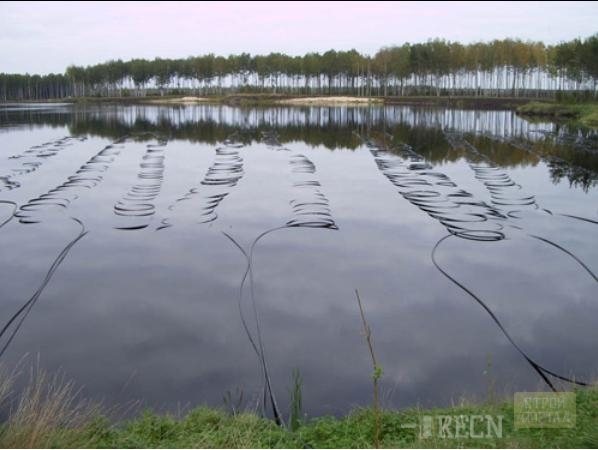
- Air heat exchanger - the external circuit takes heat from the air. They are effectively installed in the southern regions of the country. The main advantage of this scheme is the absence of any excavation work, and the disadvantage of this placement of equipment is that the efficiency of the installation drops to 100% at an air temperature of -15°C. And it is completely impossible to work at a temperature of -20°C.
Pros and cons of heating from the heat of the earth
After conducting an in-depth analysis, it was possible to highlight the negative and positive aspects of systems of this type.
pros:
- Savings : free energy from the earth is used.
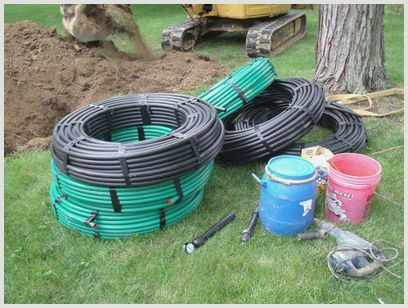
- Scale : the earth is so large that energy can be collected endlessly, especially since it is created regularly.
- Ecology : solving environmental issues related to oil, gas, and coal production.
- Autonomy of work . This energy is unlimited, thanks to which the independent work of sucking heat does not end.
- Possibility of self-assembly . Because of this, the systems became popular.
Minuses:
- If you count on long-term use, you will need to purchase a rather expensive system . The price varies between 3-10 thousand dollars.
How to do geothermal home heating with your own hands
An advanced method of geothermal home heating uses the working principle of using the heat of the earth to heat a room. Since classic fuel is an exhaustible natural resource, it is worth worrying in advance about switching to the newest limitless energy sources.
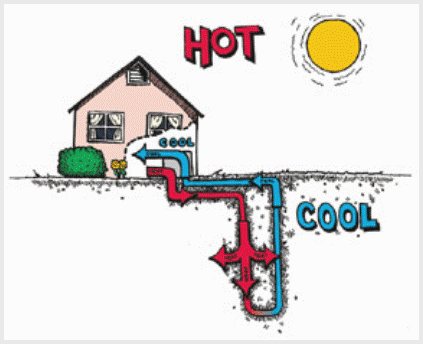
Scandinavian countries are considered the favorites in the manufacture and operation of geothermal heating systems for homes. They popularize this type of installation and recommend it to regions that have a wide potential for its application.
Construction of a geothermal heating system
Geothermy (the science of the thermal state of the Earth) has made possible the practical use of thermal energy that the earth's crust receives from the hot magma in the center of the planet.
A specially designed heat pump for heating a house is installed on the surface, and a heat exchanger is mounted in the ground or at the bottom of a reservoir. Thermal energy is “pumped out” to the surface and makes it possible to heat the coolant in the heating circuit of a house or non-residential facility.
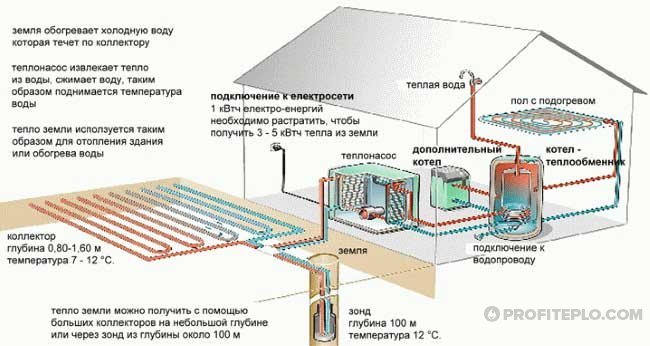
How does the heating process occur?
Geothermal heating of a private home is a cost-effective option. If you use the earth's energy to heat a house, then for every kilowatt of electricity required to operate the equipment, there is from 4 to 6 kW of useful thermal energy obtained from the bowels of the planet.
In comparison with the operation of an air conditioner, we will see that when operating it, more than 1 kW of electricity is required to produce 1 kW of thermal energy. This is due to the inevitable losses in converting one energy into another, etc.
Heating a residential building using the thermal energy of the earth’s interior is very profitable, but the payback period for the equipment and installation costs will take some time.
Using the heat of the earth to heat a house does not require installing a traditional boiler to heat the coolant.
In this case, the system consists of three components
:
- heating circuit - geothermal source of thermal energy;
- heating circuit inside the house - low-temperature radiator or floor;
- pumping station - a heat pump for pumping thermal energy into a heating circuit from a heating circuit in the soil or under water.
Geothermal heating systems can also be used to heat greenhouses, outbuildings, swimming pool water, garden paths, etc.
Equipment use
It is a mistake to believe that heat supply from the ground can only be used where there are hot water springs, warm geysers and other natural underground heating sources. Recent advances in science and technology make it possible to successfully use geothermal home heating in temperate latitudes.
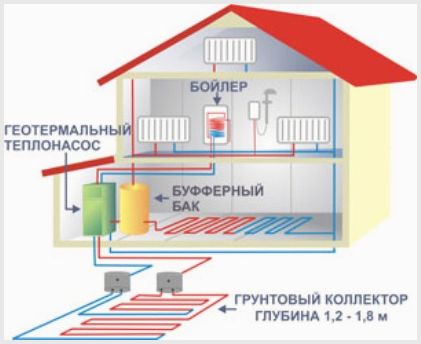
At this time in our country, this heating option is still classified as an alternative method of generating heat. But, in most cases, it is considered almost wonderful for country houses or cottages. Installed geothermal home heating
with its own hands it can work in 2 modes:
- heating in winter;
- cooling during hot weather.
In a similar way, the most suitable indoor environment is developed.
VIDEO: How geothermal heating does not stop working
System operation
A heat pump needs to be installed in the house. It will take energy from the ground or water that is in the ground, giving it to the coolant circulating in the house through the pipes. This working principle was identified back in the nineteenth century by the French physicist Sadi Carnot.
The components of a basic node are:
- air blower;
- atomizer;
- capacitor;
- throttle valve.
The air blower is responsible for “compressing” the heat and moving it to consumers. The device itself requires an external power source.
The heat pump operates according to the following method:
- The heat intake collector must contain a liquid in the middle that has a low freezing point. Often, when making geothermal heating with your own hands, water with a very high salt content, alcohol diluted with water, and glycol mixtures are poured inside.
- In the atomizer module, heat is transferred to the refrigerant, which has a low boiling point; at this time, it boils and turns into a vapor state.
- An air blower installed in the circuit helps increase the steam pressure, which results in a temperature increase of the substance to 78-80 0 C.
- Once the refrigerant substance enters the condenser, it enters the liquid phase, and at the same time energy is released for the heating circuit.
- The resulting liquid is returned to the air blower through the throttle valve.
Since a heat pump for heating a house operates on the principle of a refrigerator, it is sometimes called a “reverse refrigerator.” In most cases, energy from the ground is used to install heated floors.
Correctly carried out calculations and well-made installation of a heat exchanger can provide a fivefold increase in output power from one kilowatt consumed by the pump.
VIDEO: How a geothermal heat pump keeps running
Installation of heat exchanger
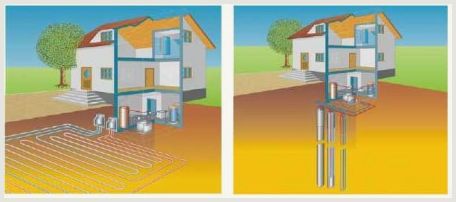
Important installation options are:
- vertical, when it is necessary to drill several wells;
- horizontal, where ditches are dug below the frost depth;
- aquatic, when the laying is carried out along the bottom of a nearby pond.
Well drilling
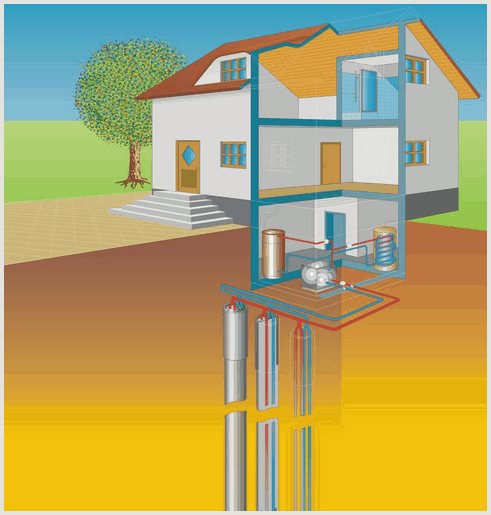
To make good use of the earth's heat energy, if the area near the structure is small, you need to drill deep wells. In the depths of the earth, a stable good temperature is maintained for several meters. The use of such geothermal wells provides heat to the heat exchanger circuit. This heat is then supplied to the second internal circuit located in the room.
Often, drilling several wells costs even less than laying the bottom of a pond. Because of this, the process becomes accessible to more people.
The process is carried out with a small drilling rig and a small amount of additional equipment. This will have almost no impact on the surrounding area. Construction of a well is permitted even in a body of water, but it should not be closer than 2-3 m from a residential structure.
The largest depth used is up to 200 m, but often success occurs from a level of 50 m. At another step, the well is constructed. A plastic tube with a diameter of 40 mm is placed inside the void. From one to four collector loops are passed into it.
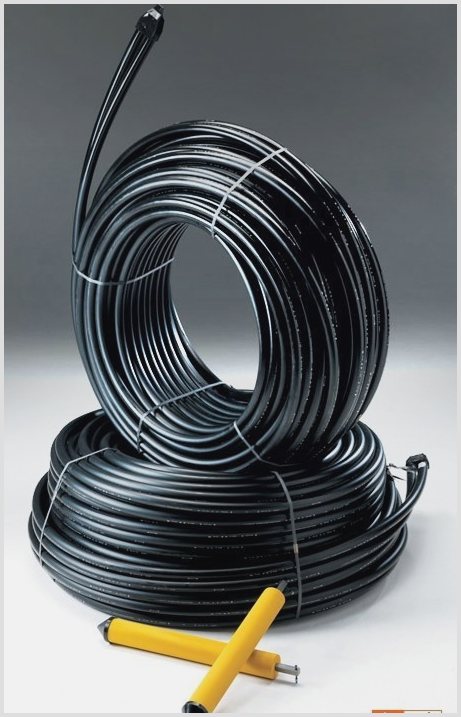
The cavity between the soil and the outer wall of the tube must be filled with heat-conducting material. The heating main is wired with a connection to the heat pump.
Water energy
This option is the most rational in terms of price, because it does not require the preparation of ditches, foundation pits and other earthworks. But such a capability is not available to everyone - the volume of the pond is very small, sufficient for home heating of 100 sq.m. must be at least 200 cubic meters and located no further than 100 meters from the construction of the house.
In ponds, pipes are laid along the bottom to prevent them from freezing during the peak of cold weather.
Carrying out calculations
To calculate the system, you need to take into account the main parameters:
- at a depth exceeding 15-20 m in central Russia, the temperature is maintained at +8-+10 0 C;
- for vertical structures, it is customary to take in calculations the resulting power value of 50 W per 1 m of height, and more accurate values depend on the degree of moisture of the rock, the presence of water in the ground, etc.;
- dry rock gives 20-25 W/m;
- moistened clay or sandstone 45-55 W/m;
- hard granite rocks provide up to 85 W/m;
- the presence of underground water gives up to 110 W/m.
Heat pump application
The longevity of the system depends on the parameters and conditions under which the heat pump continues to operate. In geothermal installations it can operate approximately 1800 hours throughout the year. This is considered the average value for latitudes without thermal underground springs.
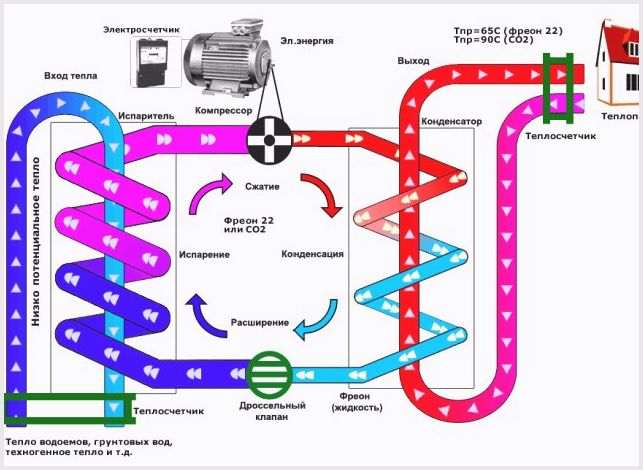
Working principle of heat pump
The working principle of the thermal heating system is similar and is not at all related to the manufacturer's state or brand. Geothermal pumps vary in design, size, and appearance, but the heat production rate will always be the same for pumps from different companies and different countries. This is associated precisely with the nature of the processing of natural energy into heat.
It is impossible to allow too much pump production, since this process can lead to a significant decrease in the temperature of the soil around the well, and sometimes leads to its freezing.
The results of such miscalculations ultimately lead to bad consequences - the earth
It begins to sag unevenly, in some places it goes deeper, which damages the protective plastic pipes. If, for example, a house is located nearby, then deformation of the foundation or walls may occur due to geological changes.
Sometimes it is necessary to take measures to “regenerate” the soil, which is why additional heat energy is supplied to the heat exchanger. This can be the energy of the solar collector or the heating of the probe when a heat pump is used in room cooling mode.
Finally, it should be said that geothermal installations are not yet available to everyone. In most cases, the payback period can last more than ten years, but, of course, in the end, these methods of heating a house will soon become not just alternative, but the only one possible.
DIY geothermal heat pump assembly
When deciding to make a geothermal pump with your own hands, you need to change the electric meter installed in the house if it can withstand a load of less than 40A. This is explained by the fact that the design consumes a very high starting current when the compressor turns on.
The average cost of components for assembling a product with a power of 9 kW/hour will be about 500 euros, taking into account the purchase of:
- Copper pipes of different diameters;
- adapters of different sizes and couplings;
- hundred-liter metal tank (stainless steel);
- deaerator;
- electrodes;
- valves acting as safety valves;
- shut-off valves;
- plastic barrel;
- the compressor itself;
- control and measuring equipment (pressure gauges, thermometers);
- freon for refilling the system;
- fasteners;
- connecting hoses;
- automation elements, etc.
A do-it-yourself geothermal heat pump is assembled in several stages. First, a compressor is selected for the future air conditioner. For example, two single-phase 24000BTU, allowing you to assemble a cascade, the total thermal power (N) will be 16 kW. When starting asynchronously, it becomes possible to reduce the required value of the starting current. They can be fixed to the wall with special brackets.
The capacitor itself can be made from a metal 100-liter tank. The tank is cut and a coil made of a tube d=10 mm (copper) is installed inside. The wall thickness of the tube used must be ≥ 1 mm. The finished capacitor is also mounted on the wall.
A do-it-yourself geothermal pump must have a coil, which is made by uniformly winding a copper tube around a metal cylinder (can be a gas one) with the same pitch.
The threaded connection is checked, after which the tank is welded.
The evaporator is made of a plastic tank with a capacity of 80 liters, inside which a copper coil made from a pipe with a diameter of ¾” is also installed. The finished evaporator is also fixed to the wall with special L-shaped brackets. The inlet and drain lines are made of a simple metal-plastic pipe.
Having acquired everything you need and completed the initial work mentioned above, it is recommended to invite a specialist knowledgeable in refrigeration equipment to complete the final assembly and carry out commissioning and commissioning work. He can assemble the system, fill it with freon, and then set it up better.






